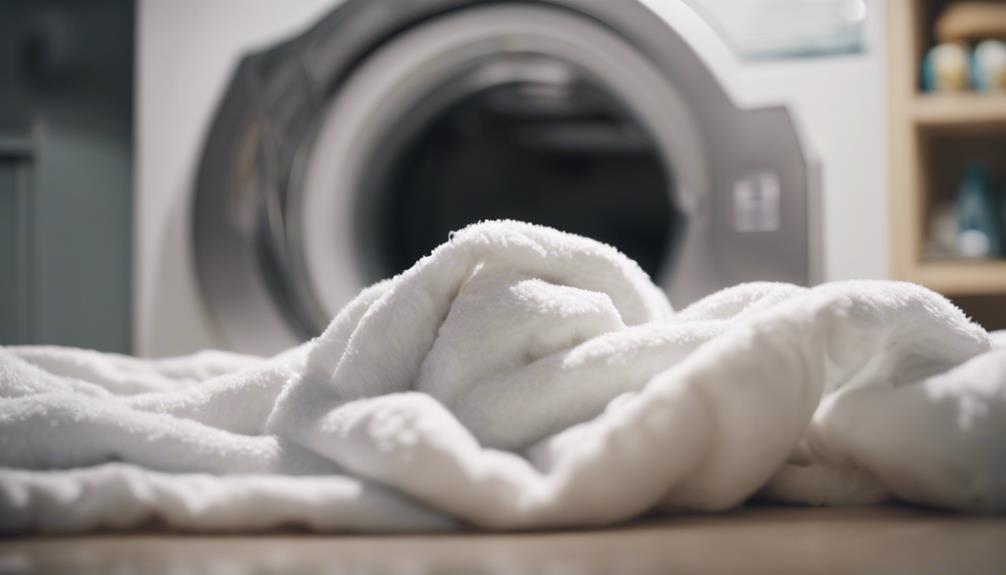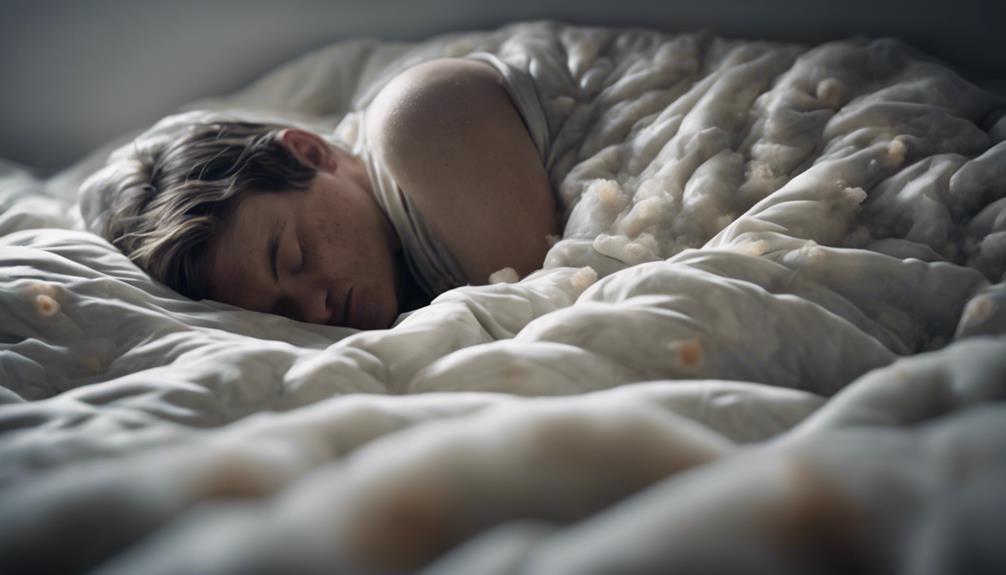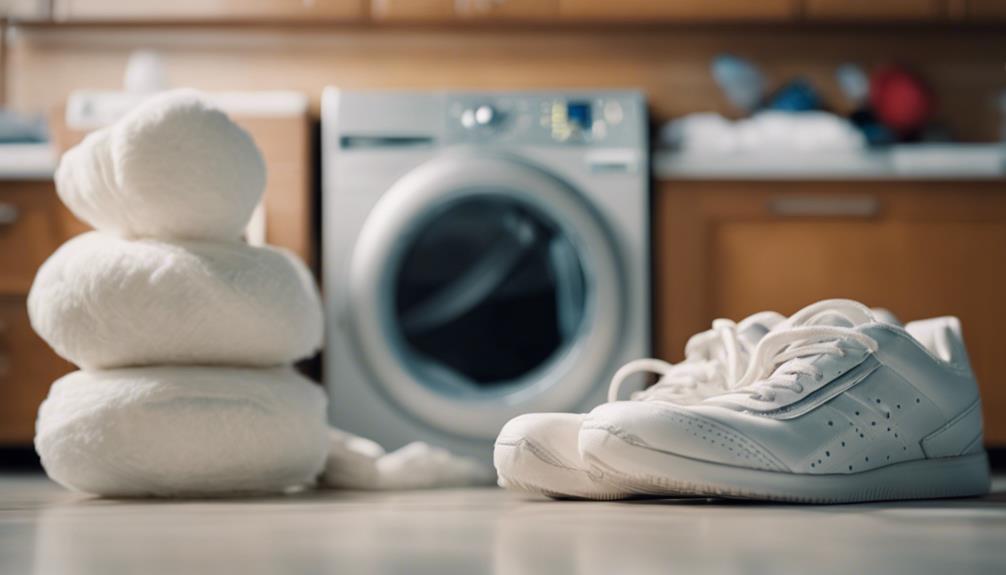If your down comforter has a scent reminiscent of wet dog, it is likely due to improper cleaning techniques that have trapped moisture, leading to the development of moldy odors and fungus. The quality of the down material plays a role in the intensity of the odor, so choosing high-quality down can help mitigate this issue. Residues present in the comforter can be activated by moisture, resulting in the unpleasant wet dog smell. To eliminate this odor, consider airing out the comforter in the sunlight or washing it with a solution of vinegar and mild detergent. Utilizing essential cleaning methods is crucial in preventing persistent odors and potential damage. For additional tips on how to maintain and eliminate odors from your down comforter, please refer to the full research.
Key Takeaways
- Trapped humidity in down comforters leads to musty odor similar to wet dog smell.
- Improper cleaning methods activate residues, causing a wet dog scent in down comforters.
- Fungus spores thrive in humid conditions, emitting a strong odor in down comforters.
- Neglecting cleaning can lead to long-term damage and persistent wet dog smell in comforters.
- Quality of down material and proper cleaning techniques are crucial to prevent wet dog odor.
Reasons for the Unpleasant Odor
Unfortunately, our down comforter often smells like wet dog due to improper dry cleaning methods that trap humidity, leading to a moldy odor. The moisture retained within the comforter creates an ideal environment for fungus growth. These fungus spores thrive in humid conditions, emitting a strong wet dog odor that permeates the fabric.
The issue is often exacerbated by the comforter cover, which can trap in the musty smell and make it challenging to eliminate. Neglecting to address this issue can result in long-term damage to the comforter, affecting its quality and lifespan.
To prevent the unpleasant smell resembling wet dog, it's essential to make sure proper dry cleaning methods are employed, allowing the comforter to thoroughly dry and minimizing the risk of fungus growth. Additionally, regularly washing the comforter cover can help in preventing the trapped odor from intensifying.
Taking these steps can maintain the freshness of the comforter and prevent the unwelcome moldy smell from developing.
Impact of Down Material Quality

The quality of the down material in comforters matters greatly. Lower quality down might hold onto more natural odors.
Opting for high-quality down can help prevent strong smells.
Down Material Sources
Exploring the sources of down material reveals how its quality directly influences the presence of unwanted odors in comforters. When considering down material sources, several key factors come into play:
- Quality of the down material
- Cleaning methods employed
- Processing techniques used
- Odor elimination procedures
The quality of down material can vary depending on these factors, impacting the overall freshness of the comforter. Proper cleaning and processing are vital in ensuring that any natural odors are eliminated.
Investing in high-quality down material from reputable sources can greatly reduce the likelihood of your comforter smelling like wet dog. By understanding the importance of down material sources, one can make informed choices to maintain a fresh and pleasant sleeping environment.
Down Quality Standards
Understanding the impact of down material quality on down comforter odor is crucial for maintaining a fresh and pleasant sleeping environment. Down quality standards directly influence the overall odor of a comforter. Higher quality down material undergoes more effective processing and cleaning, reducing potential odors. Inadequate cleaning processes can lead to residual odors lingering in the down material, affecting the comforter's smell. The source and quality of the down feathers used in the comforter play a key role in odor development. Adhering to proper down quality standards guarantees a fresher and cleaner-smelling comforter.
| Factors | Impact on Odor Development |
|---|---|
| Down quality standards | Directly influence comforter odor |
| Cleaning processes | Effective cleaning reduces odors |
| Residual odors | Inadequate cleaning leads to smells |
| Down feathers | Source and quality impact odor |
Residues Activated by Moisture
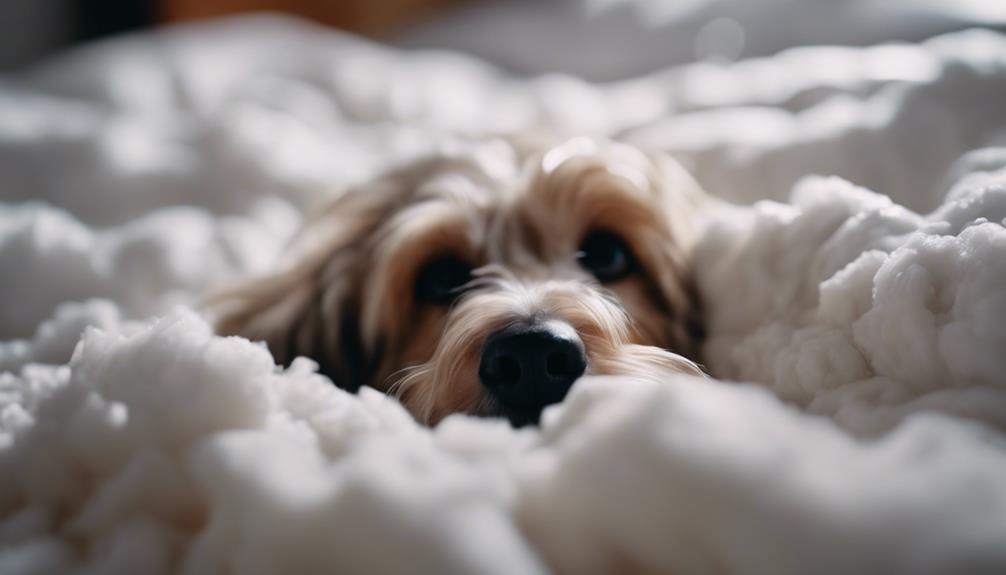
Upon exposure to moisture, residues in down comforters can be activated, resulting in the unwelcome scent reminiscent of wet dog.
- Residues in down comforters can be activated by moisture, leading to the development of unpleasant odors.
- Moisture from various sources can trigger the release of trapped residues, causing a wet dog smell.
- The activation of residues by moisture is a common issue in down comforters that haven't been properly cleaned or dried.
- Humidity in the environment can exacerbate the odor from residues, making it more noticeable.
When moisture interacts with residues in down comforters, it can trigger a pungent scent that resembles wet dog. This issue is often more pronounced in down comforters that haven't undergone thorough cleaning and drying processes. Humidity levels in the surroundings can further amplify the odor, making it harder to ignore.
To prevent this unpleasant smell, it's essential to make sure proper cleaning and drying methods are employed to eliminate residues that could be activated by moisture.
Strategies to Eliminate the Smell

To rid your down comforter of that unpleasant wet dog odor, we can employ various odor removal techniques.
Hanging it outside to air out under the sun can help eliminate the smell.
Washing with vinegar and mild detergent in a delicate setting can also tackle the issue, preventing future odors.
Odor Removal Techniques
Properly airing and sunning your down comforter can effectively eliminate the wet dog smell.
Use baking soda or vinegar in the wash to remove odors.
Consider dry cleaning or professional services for thorough odor removal.
Try scented sachets or dryer sheets to temporarily mask the smell.
Switching to alternative materials may help if the wet dog odor persists.
Preventing Future Smells
To maintain a fresh-smelling down comforter and prevent future odors, focus on airing it out regularly and using protective covers. Make sure to air out the comforter frequently to prevent moisture buildup, which can lead to unpleasant smells.
Using a duvet cover can help shield the comforter from absorbing surrounding odors. Additionally, it's essential to wash and air dry the comforter regularly to maintain its freshness and avoid odors.
Avoid storing the comforter in damp or humid environments as this can cause musty smells to develop. For a temporary solution, consider using fragrance sprays or sachets to mask any lingering odors and keep your down comforter smelling clean.
Importance of Proper Cleaning Methods

Guaranteeing proper cleaning techniques are utilized is essential in eliminating the wet dog smell from a down comforter. To effectively address the issue of a smelly comforter, consider the following:
- Use the Right Detergents: Opt for detergents specifically designed to tackle odors, such as those with enzymes or odor-neutralizing properties.
- Follow Care Instructions: Adhere to the manufacturer's cleaning guidelines to prevent damage and maintain the quality of the comforter.
- Thoroughly Dry the Comforter: Ensure the comforter is completely dry before storing it to prevent mold and mildew growth, which can contribute to unpleasant odors.
- Regular Cleaning Routine: Implement a consistent cleaning schedule to prevent the buildup of odors and maintain a fresh-smelling comforter.
Neglecting proper cleaning methods can't only result in lingering dog odors but also lead to potential damage to the comforter. By following these cleaning tips, you can effectively eliminate the wet dog smell and enjoy a fresh and comfortable sleeping environment.
Maintaining Hypoallergenic Properties
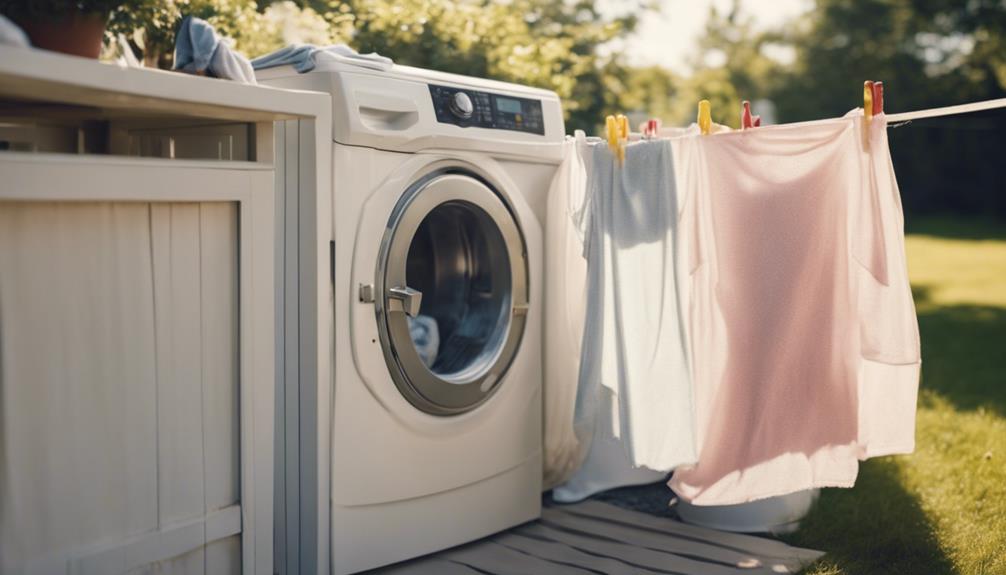
Maintaining the hypoallergenic properties of comforters requires specialized care to preserve their unique allergen-blocking features. To maintain these qualities, it's important to avoid washing hypoallergenic comforters in hot water, as this can damage the special coating that blocks dust mites and dander. Instead, opt for a gentle cycle in the washing machine with cold water.
After washing, air drying the comforter is recommended to prevent any potential heat damage that could affect its hypoallergenic properties. Seeking out French laundries or specialized laundry services can guarantee that the comforter receives the proper care it needs without harsh chemicals that could strip away its hypoallergenic features.
Additionally, using front-loading machines with less water can help reduce drying time, preserving the comforter's hypoallergenic qualities. By following these steps, you can effectively maintain the hypoallergenic properties of your comforter and continue to enjoy its allergen-blocking benefits.
Frequently Asked Questions
How Do You Get Dog Smell Out of a Down Comforter?
To eliminate the dog smell from a down comforter, consider airing it out in sunlight, using baking soda or vinegar during washing, or opting for professional cleaning services.
Scented sachets or dryer sheets can temporarily mask the odor. If the smell persists, replacing the down filling with alternative materials may be necessary.
These methods can help freshen up your comforter and rid it of any lingering dog scent.
Why Does My Down Jacket Smell Like a Wet Dog?
When down jackets smell like wet dogs, it's often due to mold growth from trapped moisture. Fungus spores thrive in humid conditions, causing that unpleasant odor.
To fix it, air dry the jacket outside in the sun or wash it with vinegar and detergent. Neglecting proper drying techniques can lead to long-term damage and lingering odors.
Remember to take care of your down jacket to avoid the wet dog smell!
Why Does My Down Comforter Smell When Wet?
When wet, down comforters can emit a smell similar to wet dog due to trapped humidity fostering fungus growth. This damp environment is ideal for fungus spores, leading to the unpleasant odor.
Neglecting proper drying methods can cause long-term damage and persistent odors. To combat this, follow specific cleaning instructions, air dry in the sun, and make sure thorough washing.
These steps help eliminate the wet dog smell from down comforters and maintain comfort and hygiene.
Why Does My Mattress Smell Like Wet Dog?
Our mattress may smell like wet dog due to trapped moisture, creating a moldy odor. Fungus spores thrive in humid conditions, causing the unpleasant scent.
Neglecting proper cleaning can lead to a lingering smell affecting our sleep quality. To guarantee the odor, we should make sure the mattress is well-aired and use appropriate cleaning techniques.
Ignoring the issue may result in long-term damage and persistent odors.
What Could Cause My Down Comforter to Develop a Foul Smell?
Down comforter odor issues can arise due to moisture buildup from body sweat and oils, or from inadequate air circulation during storage. Regularly airing out and washing your comforter, using natural odor eliminators like baking soda, and ensuring proper storage can go a long way in solving down comforter odor issues.
Conclusion
To sum up, addressing the unpleasant odor of a down comforter smelling like wet dog requires proper cleaning methods and maintenance.
Just like a well-tended garden blooms with vibrant flowers, a well-cared-for down comforter retains its cozy warmth without any unwanted scents.
Remember, a little care goes a long way in keeping your comforter fresh and inviting for a good night's sleep.



